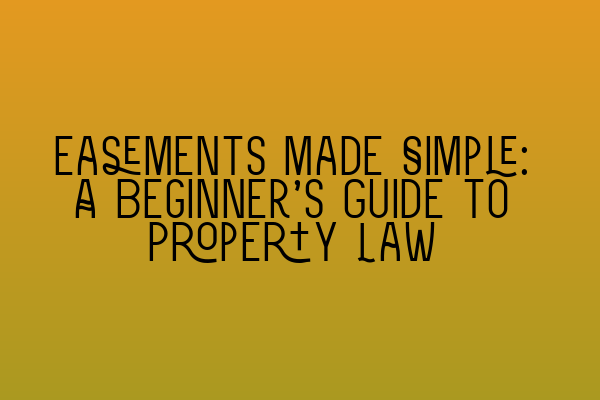Easements Made Simple: A Beginner’s Guide to Property Law
Welcome to SQE Property Law & Land Law! As leading experts in the field, we are here to provide you with a comprehensive beginner’s guide to understanding easements in property law. Whether you’re a solicitor, a law student preparing for the SQE exams, or simply an individual curious about property law, this blog post is for you. By the end of this article, you will have a solid foundation in easements and how they affect property ownership.
But first, let’s clarify what an easement is. In simple terms, an easement is a legal right that one person or entity has to use another person’s property for a specific purpose. Easements can be granted for various reasons, such as granting access to a landlocked property, allowing for utilities to pass through someone’s land, or even providing a right of way.
So, why is it important to understand easements? Well, as a property owner or a solicitor, you may come across situations where the existence of an easement affects your rights and obligations. Understanding easements will enable you to make informed decisions, advise your clients, and ensure compliance with the law.
Types of Easements
There are several types of easements, each serving a specific purpose. Let’s dive into the most common ones:
1. Right of Way: This type of easement allows someone to pass through another person’s property. It could be a footpath, driveway, or road granting access to a landlocked property. Right of way easements can be express (explicitly stated in a deed) or implied (implied by necessity or prior usage).
2. Easement for Utilities: Utility companies often require easements to install and access pipes, cables, or power lines. These easements ensure that the utility company can perform necessary maintenance and repairs without the need for constant negotiation or access disputes.
3. Easement of Light and Air: This type of easement protects the access to natural light and air for buildings. For example, if a property has windows overlooking another property, the owner of the latter may have an easement protecting their right to light and air.
4. Easement by Necessity: When a property is landlocked, meaning it has no access to a public road, an easement by necessity may be granted to provide a right of way to and from the landlocked property.
Creating and Terminating Easements
Now that we understand the different types of easements, let’s explore how they are created and terminated.
Creating an easement generally requires a written agreement between the parties involved. This agreement is usually recorded in a deed and registered with the appropriate land registry. It is important to note that creating an easement may involve the payment of compensation or consideration.
As for terminating easements, they can be terminated through various means, including:
1. Release: The dominant owner (the one benefiting from the easement) can release their rights voluntarily, effectively terminating the easement.
2. Abandonment: If the dominant owner demonstrates an intention to abandon the easement, it may be terminated. However, the abandonment must be clear and unequivocal.
3. Merger: If the dominant and servient properties come under the same ownership, the easement may no longer be necessary, resulting in its termination.
4. Expiration: Some easements may have an expiration date specified in the original agreement. Upon reaching this date, the easement is terminated automatically.
The Importance of Consulting a Solicitor
Navigating the complexities of property law, including easements, can be challenging, especially without the expertise of a solicitor. It’s always advisable to seek legal advice when dealing with easement-related matters, such as negotiating easement agreements, understanding your rights as a property owner, or resolving disputes.
At SQE Property Law & Land Law, our team of experienced solicitors can provide you with the guidance and support you need. Whether you are buying or selling a property, dealing with easements, or facing any property-related issues, we are here to assist you every step of the way.
Conclusion
Understanding easements is crucial for anyone involved in property ownership or practicing property law. By grasping the basics of easements, you can ensure compliance with the law, make informed decisions, and effectively represent your clients’ interests.
If you are preparing for the SQE exams, our related articles, such as the SQE 1 Practice Exam Questions, SQE 1 Practice Mocks FLK1 FLK2, and SQE 1 and SQE 2 Preparation Courses, can provide you with valuable resources to enhance your knowledge and prepare for success. Remember to stay informed about the latest SRA SQE Exam Dates if you have exams on the horizon.
For expert legal advice and support with easements or any property-related matters, don’t hesitate to contact SQE Property Law & Land Law. Our team is dedicated to providing you with professional and reliable assistance. Together, we can navigate the intricacies of property law and ensure your rights are protected.
